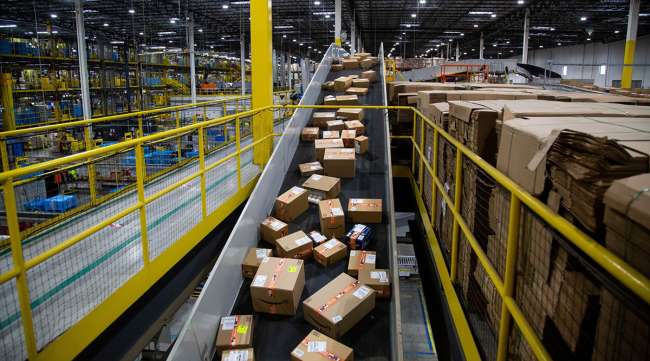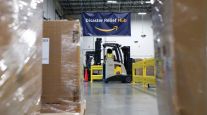Amazon Falls, Projects Slower Growth as Online Sales Stall

[Stay on top of transportation news: Get TTNews in your inbox.]
Amazon.com Inc. projected sluggish second-quarter sales growth, as consumers reduce their online spending amid rising inflation and a return to pre-pandemic activities. The shares plunged about 10% in extended trading.
Revenue will be $116 billion to $121 billion in the period ending in June, Amazon said April 28 in a statement. Analysts, on average, estimated $125 billion, according to data compiled by Bloomberg.
Amazon has been grappling with higher energy and labor costs and changing shopping habits since its online store became essential for consumers during the pandemic. First-quarter revenue from the main e-commerce business declined 3% from a year earlier. Those sales had jumped 44% in the same period of 2021 as the delta variant of COVID-19 spread across the U.S.
“This was a tough quarter for Amazon with trends across every key area of the business heading in the wrong direction and a weak outlook for Q2,” said Andrew Lipsman, principal analyst at Insider Intelligence. “The struggles begin with the commerce business, which couldn’t reverse the softening growth of recent quarters and even went negative.”

ATA's Glen Kedzie and Transport Topics' Eric Miller dive into the realities and challenges of the proposed new NOx standard, what it means for truck manufacturers and for the industry's electric future. Tune in above or by going to RoadSigns.TTNews.com.
Wall Street analysts have been nearly unanimous in their optimism about Amazon’s prospects, citing the company’s massive investments in package handling and delivery capacity and continued growth in its highly profitable cloud-computing and advertising businesses. But Chief Financial Officer Brian Olsavsky said the company’s rapid expansion left it with too much warehouse capacity and too many workers, which will take a while to work through.
Still, Olsavsky resisted the idea that consumers are pulling back from e-commerce shopping. Demand “remains strong,” he said in a briefing with reporters. “Customer-facing metrics all look good.”
Rising prices, continued supply chain issues and increased capacity built to handle the crush during the pandemic contributed to higher costs. Amazon reported $112.7 billion in total operating expenses, including $20.3 billion in fulfillment costs in the quarter ended March 31. On April 28 the company began rolling out a 5% fee charged to independent sellers on its website who use its shipping services, a move designed to blunt the impact of inflation and rising fuel costs.
“The pandemic and subsequent war in Ukraine have brought unusual growth and challenges,” CEO Andy Jassy said in the statement. “As we’re no longer chasing physical or staffing capacity, our teams are squarely focused on improving productivity and cost efficiencies throughout our fulfillment network. We know how to do this and have done it before. This may take some time, particularly as we work through ongoing inflationary and supply chain pressures.”
Sales gained 7.3% to $116.4 billion, meeting analysts’ estimates. That’s the slowest pace of growth since 2001, and marks the first time Amazon has ever recorded back-to-back quarters of less than 10% revenue growth. Unit sales, a measure that excludes cloud-computing contracts and groceries at Amazon-owned Whole Foods Market, were flat compared to the prior year, also a first for Amazon.
Want more news? Listen to today's daily briefing above or go here for more info
Amazon Web Services, the cloud unit, reported revenue of $18.4 billion, up 37%. Advertising sales increased 23% to $7.88 billion.
The company also reported a net loss of $3.8 billion, or $7.56 a share, compared with profit of $8.1 billion, $15.79, in the period a year ago. Amazon said it included a loss of $7.6 billion in non-operating expense from its investment in Rivian Automotive Inc. It was the company’s first net loss in seven years.
The shares dropped to a low of $2,560 in extended trading, after closing at $2,891.93 in New York. The stock has dropped 13% this year amid a broad decline in the S&P 500.
Amazon.com Inc. ranks No. 22 on the Transport Topics Top 100 list of the largest private carriers in North America.




